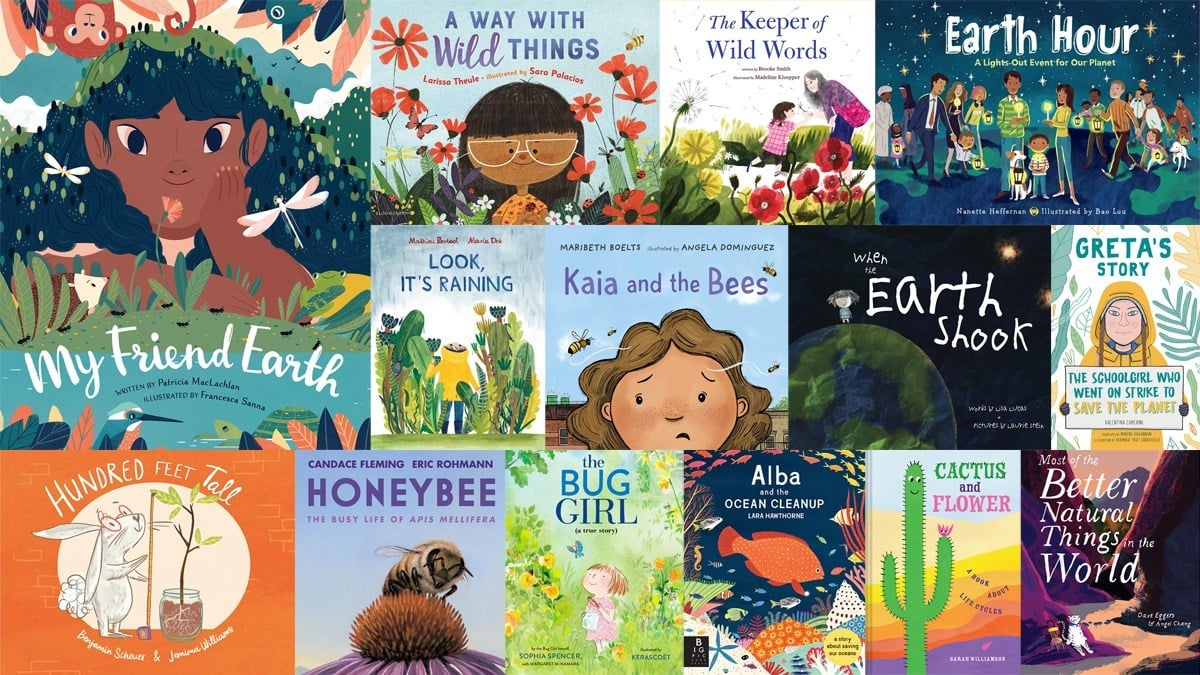This Wednesday is the 50th Earth Day, and although many of us around the world are still sequestered, in many places it’s still possible to get outside separately and enjoy the outdoors. (Just keep your distance!) I’ve been reading lately that because people are driving less due to all these restrictions, one of the unexpected benefits is that the air is cleaner, particularly in big cities. I hope that after the pandemic has been contained and restrictions are lifted, that we find ways to continue driving less, now that we’ve seen what a big difference it can make.
In the meantime, today I’d like to share some books with you about nature! Some of these are specifically about conservation and care of the environment, and some are just stories about animals or plants.
Most of the Better Natural Things in the World written by Dave Eggers, illustrated by Angel Chang
This book is a list of various words describing features in the natural landscape: lagoon, chaparral, tundra, estuary, and many more. Each scene is beautifully illustrated, as a white tiger travels through them carrying a chair on her back. Where is she going? Why does she have a chair with her? There aren’t any other words, just a wonderful selection of terms—archipelago, foothills, isthmus—in an otherwise wordless journey through gorgeous vistas (that’s another word!). At the end of the book there’s a glossary defining all the terms.
The Keeper of Wild Words written by Brooke Smith, illustrated by Madeline Kloepper
Young Brook goes to visit her grandmother Mimi, who appoints her with an important task: she is to be the Keeper of Wild Words, “ready to see and hear and feel” the various words so that she’ll remember them. The two of them go out into the meadows and forests, noting things like buttercups and ferns and minnows, checking off words from the list.
As the author’s note explains, this book was inspired by an article that the Oxford Junior Dictionary had removed a long list of nature-based words in its recent edition because it felt they were no longer relevant, replacing them with words like “chatroom” and “MP3 player” and “voicemail.” Smith, angry and sad about the loss of these words, wrote this book to include several of the words that had been lost, and encourages kids to continue keeping wild words. At the back of the book is a built-in envelope where kids can store their own wild words.
My Friend Earth written by Patricia MacLachlan, illustrated by Francesca Sanna
This lovely picture book takes us through the seasons of the year, with Earth personified as a giant girl who tends to the animals, pours down rain, and sprinkles snow over the plants and animals. The text describes “my friend Earth” and her activities as the seasons change. The illustrations are delightful, and make use of cut-outs that let sections of the pictures peek through from the next page.
A Way With Wild Things written by Larissa Theule, illustrated by Sara Palacios
Poppy is a young girl who loves nature: she likes bugs and blending in with flowers, and she’s a bit shy around people. When Grandma Phyllis turns 100 and the whole neighborhood turns out for the party, Poppy doesn’t want to be the center of attention. But then a beautiful dragonfly makes an appearance, and suddenly Poppy finds everyone’s eyes turning toward her. This book is a celebration of kids who are introverted or shy, and the worlds that they inhabit, along with the little creatures around us that many people might miss.
The Bug Girl (A True Story) written by Sophia Spencer with Margaret McNamara, illustrated by Kerascoët
Speaking of kids and bugs, The Bug Girl is a true story about Sophia Spencer, a girl who made headlines a few years ago: she’d grown up loving bugs, but when she got to the first grade, kids made fun of her and she felt discouraged. Her mother contacted some entomologists, who rallied and sent encouragement to Sophia, proclaiming their own love for bugs and showing her that she wasn’t alone. This picture book tells her story, and ends with a section about bug facts, including Sophia’s top 4 bugs.
Kaia and the Bees written by Maribeth Boelts, illustrated by Angela Dominguez
Here’s another one about a little girl and insects—but this time, her relationship with them is a little less friendly. Kaia is terrified of bees, even though her father keeps bees on the roof of their apartment building. She eventually works up the courage to accompany him to the roof while he’s taking care of the bees, and delights in the golden honey they produce. The fear of getting stung doesn’t entirely go away, but she learns why bees are important and appreciates them by the end.
Honeybee: The Busy Life of Apis Mellifera written by Candace Fleming, illustrated by Eric Rohmann
Honeybee follows the life of a honeybee from its birth through its very busy life. I hadn’t realized all the many things that a worker bee does before it actually takes flight! The book describes the various tasks in detail, and then teases the reader with hints of “the next job”: is it flying? Nope, not yet. But then, of course, at least the honeybee takes flight, collecting nectar and pollinating flowers and dancing for the rest of the bees to direct them to the flowers. The illustrations by Rohmann are very realistic; at first I assumed the cover was a photograph until I looked again. This one’s a great book for kids who want to know more about the life cycle of a bee.
When the Earth Shook written by Lisa Lucas, illustrated by Laurie Stein
Alya and Atik are two stars, shining in the night sky at a little planet called Earth, who loved their twinkling. But eventually humans came along and the skies became filled with pollution, and it got harder and harder for Earth to see Alya and Atik, and Earth cried and shook. It took a little girl to listen to Earth, and shout instructions to everyone about how to make Earth feel better. Although the the girl in the book is named Axiom, it’s not hard to see her as a stand-in for Greta Thunberg, as she stands up to the king and his three friends, the ones who refuse to heed her instructions.
The illustrations are a mix of drawings and collage, often on crumpled brown paper, and help to make it feel like a fable. Axiom’s message that closes out the book steps out of the story-like language and is a direct call to action: reducing our carbon footprint by driving less, not eating meat, avoiding plastic packaging, and so on. The book gives Earth and the stars a voice, but shows that it’s up to humans to change their behavior to help, while also acknowledging that not everyone will agree.
Hundred Feet Tall written by Benjamin Scheuer, illustrated by Jemima Williams
Continuing in the vein of small things making a big difference, this story is about a rabbit who plants a tiny seed and nurtures it, dreaming of the day it will stand “a hundred feet tall.” The book shows the slow growth of the tree, and the excitement of anticipation. The story is in verse, and the endpages include a melody composed by Scheuer so you can sing it as a song, too.
Cactus and Flower: A Book About Life Cycles by Sarah Williamson
This colorful book is about a friendship between Cactus and Flower, who share the days together as they watch butterflies, look for constellations in the sky, and play with the various animal friends that surround them. But while Cactus and Flower slowly grow, Flower begins to lose petals, and is eventually gone. Over time, a new Flower blooms on Cactus. The book is inspired by the natural life cycle of cacti, and though it doesn’t make it explicit, seems to suggest that friendships may not last forever. We should make the most of our time together and it’s okay to mourn the loss of a friend, and at the same time there are new friendships that will blossom in time.
Look, It’s Raining written by Mathiew Pierloot, illustrated by Maria Dek
Camille is bored and sneaks outside for a walk, where it begins to rain. But that doesn’t deter her. In fact, Camille delights in the storm, soaking up the rain and talking to all sorts of insects and other creatures who are all on their way to “a show.” It turns out to be a butterfly emerging from its chrysalis, just as the storm lifts. The story has a pretty simple message: get outside and pay attention!
Alba and the Ocean Cleanup by Lara Hawthorne
Alba is an orange fish who lives in a beautiful reef filled with other corals and fish, and she loves to collect beautiful shells and items for her collection. But every year, there’s a little bit more trash, shells become harder to find, and there are fewer of her friends around to celebrate her birthday. Things finally come to a head when Alba gets trapped in a plastic bottle trying to fetch a shiny pearl. Fortunately, Alba is discovered by a little girl on a beach, who spreads the word about Alba and organizes an ocean cleanup in her town, restoring the reef’s health and making the seas a little bit safer bit by bit.
The message of this book is pretty straightforward: we need to take care of the oceans. The back of the book lists a few steps to take, like reducing our use of plastic and picking up trash on the beach, as well as avoiding pouring harmful chemicals down the drain. There’s also a page with various sea creatures that you can look for in the rest of the book.
Earth Hour: A Lights-Out Event for our Planet written by Nanette Heffernan, illustrated by Bao Luu
I’ve already missed this year’s Earth Hour event, but I felt like this book is still a good fit for today’s topic. Earth Hour is held every year on a Saturday near the equinox in March, starting at 8:30pm in your own time zone. The idea is that for one hour that evening, everyone turns out their lights. Many famous landmarks such as the Sydney Opera House, as illustrated in this book, also turn out their lights during Earth Hour. It’s a small action that is largely symbolic, but is meant to serve as a reminder to conserve energy the rest of the year as well. The book notes the many ways that we use energy—to keep us warm, light our homes, wash our clothes—but also reminds us that turning off lights (and other devices) is one way to battle climate change.
Greta’s Story: The Schoolgirl Who Went on Strike to Save the Planet written by Valentina Camerini, translated by Moreno Giovannoni, illustrated by Veronica Carratello
I’ll end today’s column with a non-picture book. This is a biography of Greta Thunberg and the story of how her solo protest grew into a worldwide movement, with students across the globe joining her in the School Strike 4 Climate. Whether you’re a fan of Thunberg or not, there’s no denying that she has been able to highlight climate change and spur conversation about it, particularly among the youth, who will be most affected by the policies and decisions that are being made today. This book tells Thunberg’s story in plain, kid-friendly language, describing her journey and how she inspired students everywhere.
My Current Stack
Aside from a stack of comic books (which I’ll share with you next week), I finally finished reading A Game of Birds and Wolves by Simon Parkin, which I mentioned last month in a column for Women’s History Month. It always takes me longer to read non-fiction than fiction, and this one in particular had me bogged down with lots of factual details. I have to say, I was a little disappointed that the book didn’t have more details about the Wrens themselves, particularly given that the subtitle implies that it’s about these young women who played a significant role in the sea battles of World War II. It wasn’t until the epilogue of the book that I understood why: after the war ended, the role that the WATU played, with their sea battle game that was used to develop strategies against Germany’s U-boats, was classified. For the most part, the Wrens were prohibited from telling their stories, and many of them didn’t even tell their own families of the important work they’d done. Those that wrote about their experiences mostly did so much later, when many details had been forgotten, so there simply wasn’t a lot of documentation, which is a tragedy. While I wasn’t a huge fan of the way Parkin tells it (sometimes there were huge info-dumps that seemed only peripherally connected to the current storyline), I did find the story fascinating, and a testament to the way that playing games can have serious and far-reaching consequences beyond simple entertainment.
Disclosure: I received review copies of these books.
Click through to read all of “Stack Overflow: Happy Earth Day!” at GeekDad.If you value content from GeekDad, please support us via Patreon or use this link to shop at Amazon. Thanks!



















